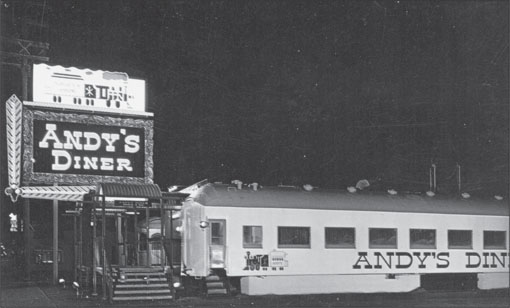
The crème de la crème of Seattle does not necessarily mean the fanciest restaurants, although those are a big part of this section. These are haunts that Seattleites have enjoyed through the years.
The Pacific Northwest is rich in sea fare; broiled salmon is one of the biggest sellers. Another big seller is Dungeness crab from Anacortes. Pan-fried Olympia oysters and oysters Rockefeller are served fresh in the Northwest. Quilcene oysters, which got their start in Japan, are on several menus in the area. Clams from Puget Sound, which were eaten by the Native Americans, are still a favorite today. There are also the razor clams, rock clams, butter clams, and the geoduck (gooey duck). Local Native Americans used to collect barnacles and boil them for their chiefs as a delicacy, but they will not be found on any menu here now.
The geoduck, native to the Pacific Northwest, is the largest burrowing clam in the world, weighing in between one and three pounds. It has a life expectancy of about 146 years and sells for more than $30 a pound in Asia. In Washington, it is about the ugliest clam ever seen and is usually made into the tastiest clam chowder ever eaten.
New England and Manhattan clam chowder are probably on almost everyone’s menu in the Pacific Northwest. In the 1950s, Canlis offered a mahimahi chowder (Canlis’s Own Hawaiian Chowder) for $1.25, and today the Canlis chowder (made from Dungeness crab, prawns, and Manila clams in ginger-scented cream) is offered for $11.
Seattleites and visitors alike have enjoyed fresh seafood paired with charcoal broilers for some time. While restaurants have come and gone, a few have stood the test of time.
ANDY’S DINER. Andy’s Diner originally was opened in 1949 by Andy Nagy. Bill Howard (one of three partners) bought the diner in July 2000. After being open for more than 50 years, it closed its doors in January 2008. Roger Shannon said, “I used to go to lunch there twice a week. “Big Andy” Nagy weighed 120 pounds, and his son, known as “Little Andy,” weighed more than 250 pounds.” (Courtesy of John Cooper.)
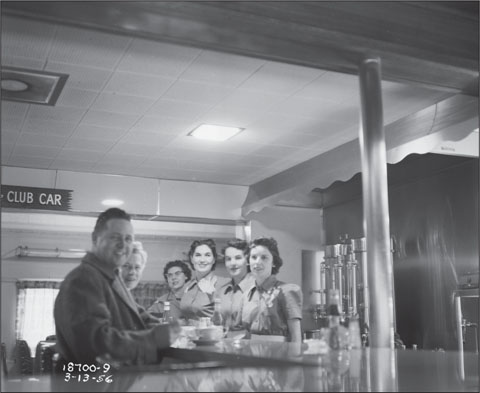
ANDY’S DINER, INSIDE. On March 13, 1956, unidentified diners and waitresses are pictured in the Club Car at Andy’s railroad car diner, located at 2723 Fourth Avenue South in Seattle. Historic railroad pictures lined the walls. A charcoal broiler was in the center of all of the activity. (Courtesy of the Seattle Municipal Archives, No. 53137.)
ANDY’S DINER MENU. This wooden menu says, “Andy’s Diner in Seattle, Washington, is the outstanding diner west of the Mississippi river . . . featuring only the finest eastern corn-fed beef available. A trip to Seattle isn’t complete unless you make Andy’s Diner your mealtime headquarters. From the Charcoal Broiler; a prime favorite in every gourmet center of the world—the tenderest, most nutritious cuts of meat in the world. Call SE 4295.” (Author’s collection.)
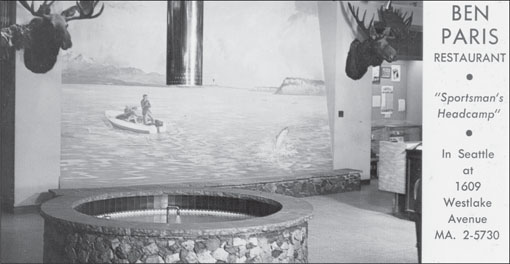
BEN PARIS RESTAURANT. This undated postcard shows the Ben Paris Restaurant, which was located at 1609 Westlake Avenue. A quote on the back reads, “The world-famous Ben Paris Restaurant in Seattle is truly the sportsman’s family headquarters for delightful dining in an atmosphere giving you that great outdoor feeling. Complete line of sporting goods for the fisherman or hunter and the latest dope. Tobacco, pipes and the Sportsman’s Cocktail Lounge.” (Author’s collection.)
BEN PARIS RESTAURANT, 1959. The Ben Paris Restaurant was a Seattle institution for many years. It was a combination of a restaurant, bar, pool hall, and sporting goods store. It was located on the northeast corner of Fourth Avenue and Pine Street on the lower level of the Eitel Building. In the late 1920s, Ben Paris’s Terminal Concessions Company and Bartell Drugs entered mutually into a 76-year lease of the Eitel Building. In 1946, the Eitel Building was sold to L. E. Nudelman. In 1948, Bartell Drugs and Ben Paris still occupied the street fronts. (Courtesy of the Robert H. Miller Collection, MOHAI, No. 1959 2002.46.10.)
CANLIS CHARCOAL BROILER. Featured on the postcard above is an exterior view of the Canlis Charcoal Broiler. In 1949, Canlis became the most expensive restaurant built in the past 30 years. It is still located at 2576 Aurora Avenue North. (Courtesy of R.V. Parks.)

PETER CANLIS. Before long, the name Canlis had become synonymous with fine dining in four major cities: San Francisco, California; Honolulu, Hawaii; Portland, Oregon; and Seattle, Washington. The Seattle location was the crown jewel for Canlis. It was here that Canlis introduced fine dining to a city that had never had a dinner house, an a la carte menu, or liquor by the drink. (Courtesy of Canlis.)
PETER CANLIS DINING. Peter Canlis’s life story is that of the Canlis restaurants. Peter Canlis was flamboyant and hardworking, and he set out to make a name for himself. Quoted from the Canlis Web site is the following: “Great Grandpa Nicholas Peter Canlis was a wild hare. Born in Greece in 1881 under the Ottoman Empire, he set off to make his fortune. Moving through Constantinople and ending up in Egypt, he took work at the Mena House, Cairo’s most famous hotel. The Mena always attracted the rich and the powerful. Winston Churchill, Charlie Chaplin, the Aga Khan, and Omar Shariff were all regulars at the hotel.” Author Robin Shannon’s favorite hotel is also the Mena House. Another quote from the Canlis Web site says, “Fifty years later, Peter Canlis’s jewel is marvelously run by the next generation of family restaurateurs, Brian and Mark Canlis, preceded by their parents Chris and Alice. Together, they have preserved the traditions of this famous landmark while adding their creativity and energy to Canlis.” (Courtesy of Canlis.)
CANLIS MENU. Canlis was the first Pacific Northwest restaurant to feature an open charcoal grill where guests could watch chefs grilling prime, Midwest, dry-aged steaks; king salmon; and fresh Pacific mahimahi over Kiawe charcoal brought in from Hawaii. In an era when “a la carte” was unheard of in the West, Canlis introduced Seattleites to the “Gargantuan Idaho Baked Potato—tubbed, scrubbed, and old-rubbed” at the astronomical cost of 50¢. (Author’s collection.)
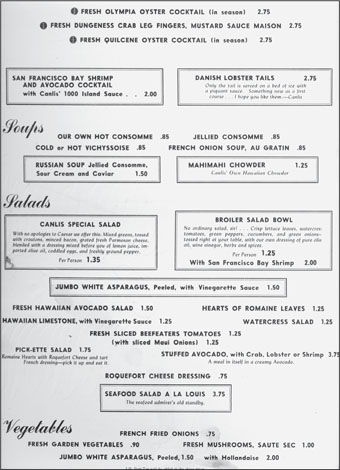
CANLIS MENU (INSIDE). Canlis is famous for its special salad, which is made with mixed greens tossed with croutons, minced bacon, and grated fresh parmesan cheese, then blended with a dressing made from lemon juice, imported olive oil, coddled eggs, and freshly ground pepper. Rachel Lund, the private dining and promotions assistant for Canlis, said, “If we ever took that salad off of the menu, we would have a riot on our hands.” (Author’s collection.)
CASA VILLA. A touch of old Italy, the Casa Villa, was located at 1823 Eastlake Avenue in a peach stucco Italian villa. Dinners started with an appetizer plate of cold meats, olives, canapés, and peperoncini, then a vegetable salad with salsa condita (dressing), and next a native Milan minestrone soup. The entrée was spaghetti and ravioli, and for dessert there were petite fours and homemade spumoni. For $1, a person could eat as many entrées as they wished. (Author’s collection.)
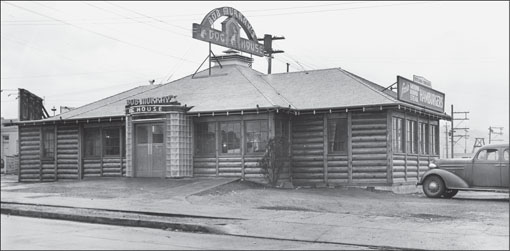
THE DOG HOUSE RESTAURANT. Bob Murray’s Dog House opened in the 1930s and closed in 1994. “All Roads Lead to the Dog House” was one of the business’s most famous mottos. Reporter John Hahn wrote that, “The Dog House was an epoch of Seattle history, a virtually non-stop, open-24-hours, run of food, booze, music, and fellowship.” (Courtesy of the Seattle Post-Intelligencer Collection, MOHAI, No. 1986.5.11356.)
THE DOG HOUSE MENU. The motto of the Dog House was, “Where friends meet friends.” The cocktail lounge had pictures of dogs on the walls, and in the rear of the café area, pictures of Seattle University basketball players hung on the walls. (Author’s collection.)

DOG HOUSE MENU (INSIDE). The Dog House was located at 2230 Seventh Avenue. The menu states, “Our hamburgers are all meat.” The manager for most of the 60 years that the Dog House was open was Laurie Gulbransen (1913–2000). (Author’s collection.)
CRAWFORD’S SEA GRILL. Crawford’s Sea Grill specialized in seafood, steaks, chicken, and chops. Ivar Haglund, a Seattle character and restaurateur, was known as “King of the Waterfront” and later opened Ivar’s Captain’s Table on this same site, located below Queen Anne Hill. (Author’s collection.)
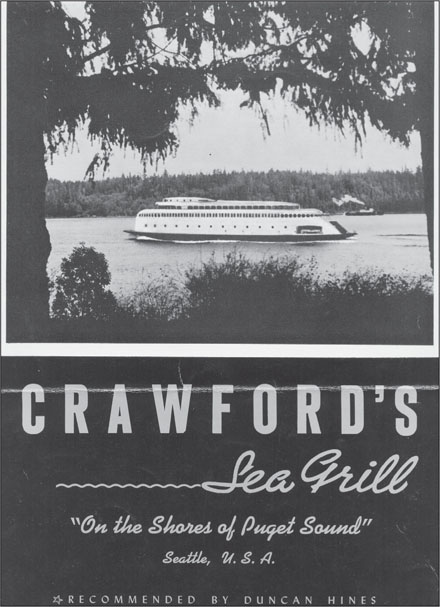
CRAWFORD’S SEA GRILL MENU. An advertisement for Crawford’s Sea Grill and Coral Room, printed in the 1958 city directory, publicized the restaurant’s location on the shore of Puget Sound. The restaurant claimed to have “the finest seafood in the nation.” Located at 333 Elliott Avenue West, the restaurant had seating for more than 100, and the glass-enclosed dining room had a view of Elliott Bay. (Author’s collection.)
CRAWFORD’S SEA GRILL MENU (INSIDE). Nick Zanides was the owner and operator of Crawford’s Sea Grill. This menu, dated November 26, 1942, featured fresh, seasonal seafood and was subject to fishing conditions, such as abalone for the cost of $1.15 to $1.25 or lobster thermidor for $1.40. (Author’s collection.)

CRAWFORD’S CORAL ROOM. Pictured here is a drink menu from Crawford’s Coral Room. Both the cocktail lounge (on the second floor) and restaurant had huge windows to enjoy the view of trains roaring past and pleasure boats on Elliott Bay. Nick Zanides grew more than 500 rose bushes along the fence by the railroad tracks. (Courtesy of Ed and Colleen Weum.)
THE GOLDEN LION. The Golden Lion restaurant was located in the Olympic Western Hotel at Fifth Avenue and University Street. It had a romantic atmosphere of the British Colonies and featured waiters in turbans serving flaming entrees. Retail space would later replace the Golden Lion. (Courtesy of Mary Patterson.)
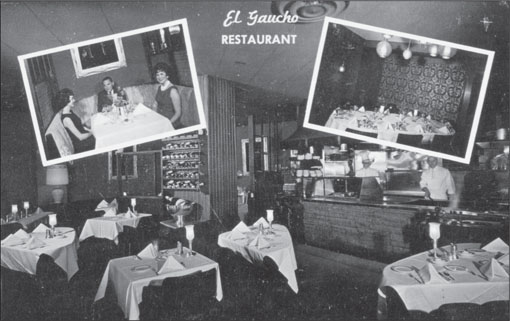
THE EL GAUCHO. Above is an ektachrome postcard by Clifford B. Ellis of the El Gaucho restaurant located at Seventh Avenue and Olive Street. It was internationally acclaimed for fine steaks and distinguished decor. Shown is the Mink Booth, where important people from world affairs, entertainment, and sports met to dine. The Gold Room was ornately complemented with famous El Gaucho $4,000 gold-plated flatware for private parties. (Author’s collection.)
THE EL GAUCHO BAR. This photograph, taken on St. Patrick’s Day, March 17, 1959, shows an unidentified bartender with customers at the bar wearing their shamrock hats. The usual decor of El Gaucho was of cowboys of the Pampas with dark-haired waitresses in fiesta skirts wearing off-the-shoulder blouses waiting on tables. The El Gaucho restaurant, which opened in 1954, is well known for its 28-day, dry-aged, certified, Angus beef prime; Caesar salads tossed tableside; and flaming shish kebabs called “en espanada flamente.” Founder Paul Mackay recalls that, “The first time I walked into the Gaucho, the ambiance hit me. It was the most stunning place I had ever seen in my life, and I thought that sometime I would like to work there.” El Gaucho is still open, and El Gaucho Bellevue is the fourth location to open in the fall of 2008. The restaurants are also known for a nightly piano bar and the famously nostalgic, 1950s “retro-swank” atmosphere. (Courtesy of the Robert H. Miller Collection, MOHAI, No. 2002.46.15.)
GEORGIAN ROOM MENU. On the cover is an image of women eating in the Georgian Room at the Olympic Hotel in Seattle in 1948. Multiple lunch and dinner menus with various covers were used during the 1950s. On the back of this menu, Tom Gildersleve is listed as the general manager in Seattle. The Georgian Room was the Olympic Hotel’s main dining room. (Author’s collection.)

GEORGIAN ROOM DINNER MENU (INSIDE). The Georgian Room dinner on Monday, April 4, 1949, featured hors d’oeuvres, soup, and an entrée, including dessert, for a total price, depending on the entrée chosen, ranging from $2.95 to $4.35. Planked Chateaubriand for two cost a mere $10. Charles Eusebe was the chef de cuisine, and Harold Hallstrom was the maitre d’hotel. (Author’s collection.)
GREEN APPLE PIE SHOP POSTCARD. Located at 521 Pike Street, this restaurant sold sandwiches as well as a famous green apple pie for 10¢ a slice. Other pies were fresh huckleberry, apricot, cherry, pineapple cream, hot mince, and pumpkin, which also cost only 10¢ per slice. (Courtesy of John Cooper.)
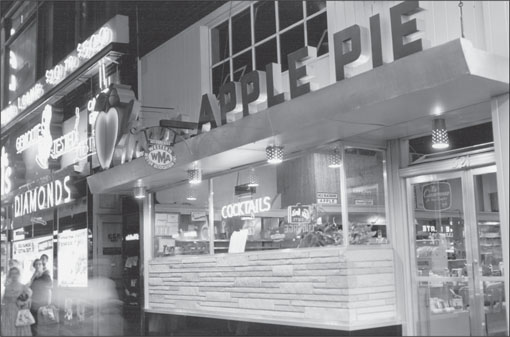
GREEN APPLE PIE SHOP. During World War II and in the postwar years, the Green Apple Pie Shop was a popular eatery in downtown Seattle. It was recommended by the Western Motor Association. (Courtesy of the Robert H. Miller Collection, MOHAI, No. 2002.46.22.)
GREEN APPLE PIE SHOP. This photograph is of the interior of the Green Apple Pie Shop showing the streamlined spotless café and counter. (Courtesy Robert H. Miller Collection, MOHAI 2002.46.23.)
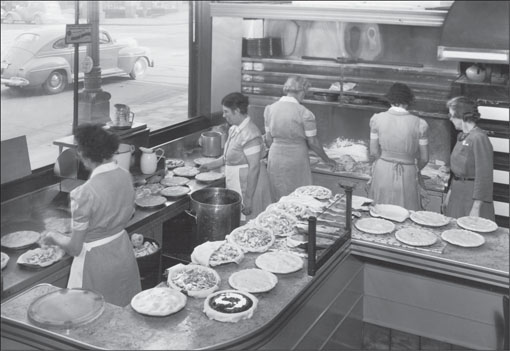
GREEN APPLE PIE SHOP KITCHEN. Photographed in 1945 by Webster and Stevens, these women were making pies at the Green Apple Pie restaurant. (Courtesy PEMCO Webster and Stevens Collection, MOHAI 1983.10.15338.1.)
HYATT HOUSE. This 1976 postcard shows the Seattle Hyatt House, which was located at the Seattle-Tacoma International Airport at 17001 Pacific Highway South. An extravagant weekend package for two at this resort-type motel cost $29.50. The restaurant was cosmopolitan and featured roast Long Island duck and chicken a la kiev. (Author’s collection.)
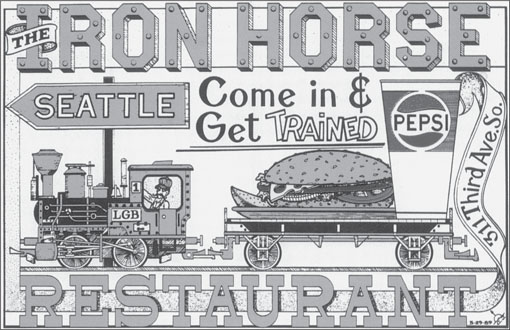
THE IRON HORSE RESTAURANT. Known as Seattle’s most unique dining spot, this restaurant delivered meals to the table by large-scale model trains. The Iron Horse Restaurant was located in the historic Pioneer Square District. Children were welcome, while adults were tolerated if sufficiently immature. (Courtesy of Robin Anderson.)
ITALIAN VILLAGE CAFÉ. This 1936 photograph shows the Italian Village Café and the surrounding businesses located in the 1400 block of Fifth Avenue. (Courtesy of the Seattle Post-Intelligencer Collection, MOHAI, No. 1986.5.11368.1)
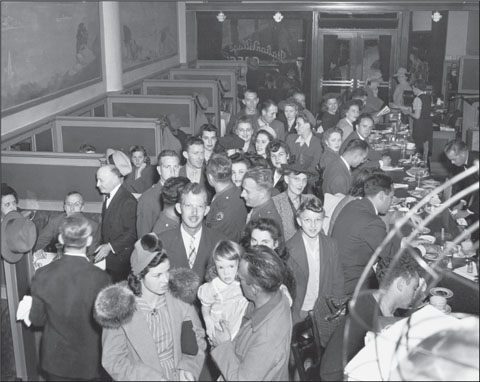
ITALIAN VILLAGE CAFÉ CROWD. A crowd gathers inside the Italian Village Café in Seattle on September 29, 1942. The café was a popular downtown eatery. (Courtesy of the Seattle Post-Intelligencer Collection, MOHAI, No. 1986.5.11369.)
ITALIAN VILLAGE RESTAURANT MENU. The Italian Village Café was located at 1413 Fifth Avenue. This menu was dated Thursday, September 6, 1951. (Author’s collection.)

ITALIAN VILLAGE CAFÉ MENU (INSIDE). On this page of the menu, one could order a combination dinner for $1.75 or $2.30. On the back of the menu was written: “De Luxe Dinner $3.50—A genuine 8 course Italian dinner with tenderloin steak or spring chicken.” (Author’s collection.)
IVAR HAGLUND. An Alaskan Way messy syrup spill provided Ivar Haglund an occasion to create a “gooey” scene. In Seattle in 1947, while a tanker car was being loaded, a coupling broke, and out poured thousands of gallons of sticky corn syrup. The spill occurred at Alaskan Way and Columbia Street. The Corn Products Refining Company used the glucose for candy and syrups. The congealing mess had to be heated with steam so the clean-up crew could scoop it up with coal shovels and dump it into barrels. Haglund, being a prankster, threw on some hip boots, grabbed some pancakes from his restaurant, and trotted across the road to pose for photographer John M “Hack” Miller. As the reporter noted, “What he puts on his customers’ hot cakes from now on is anybody’s guess.” (Courtesy of the Seattle Post-Intelligencer Collection, MOHAI, No. 1986.5.27280.)
IVAR’S ACRES OF CLAMS RESTAURANT. Above is a real-photo postcard of Ivar’s Famous Seafoods, located on Pier 54 in Seattle. One slogan was, “What with the city’s leading professional men, artists, writers, world travelers, and visiting VIP’S always dropping into the place, it has become the spot where clams and culture meet.” (Courtesy of John Cooper.)

IVAR’S DINING. Overlooking the water, the informal restaurant has been a Seattle waterfront tradition since 1938. Owner Ivar Haglund decorated his restaurant with aquatic-type gear, funny signs, and nets with glass balls throughout the beamed ceiling. There is a sit-down restaurant inside and a fish bar on the outside where one can order seafood to go. (Courtesy of John Cooper.)
IVAR’S FIFTH AVENUE FISH HOUSE. Above is a postcard of Ivar Haglund’s upscale Fish House. A quotation from the restaurant’s Web site reads, “Have you lost yourself lately in the gastronomical delights of Ivar’s Acres of Clams or Ivar’s Fifth Avenue?” (Courtesy of John Cooper.)

IVAR’S FIFTH AVENUE SEAFOODS MENU. Don’s Seafoods, which opened in 1898, was the oldest seafood restaurant in Seattle. The Fifth Avenue Whaling and Trading Corporation owned Ivar’s Fifth Avenue Seafoods and took over one of Don’s Seafoods’ locations. Ivar Haglund also owned the Ivar’s Acres of Clams restaurant. (Courtesy of Nancy Leson, Seattle Times.)
IVAR’S PIER 54 MENU (INSIDE). Pictured here is an early menu from Ivar’s Pier 54, showing why one’s elders complain about today’s high prices. The restaurant also had a menu shaped like a clam. An order of fish and chips cost 85¢ a la carte or a full course dinner cost $1.35. (Author’s collection.)
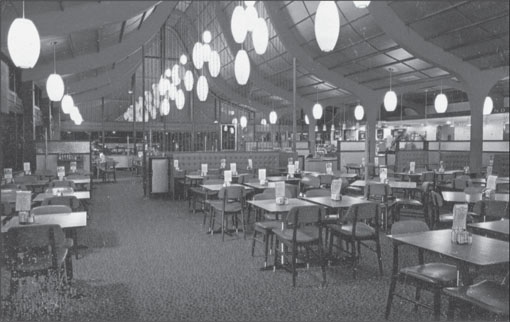
MANNING’S CAFÉ. This postcard shows Manning’s in Ballard. It was a caféteria and buffet that served family-style food prepared by all-women cooks. Manning’s was located at 5505 Fifteenth Avenue NW in Seattle. (Author’s collection.)
KING OSCAR’S RESTAURANT. King Oscar’s Smorgasbord was located at 4312 Aurora Avenue North. This photograph was filed by the Seattle Post-Intelligencer on November 22, 1959, but the family looks to be dressed in Easter clothes. This Swedish restaurant had several famous guests, including the crown prince of Denmark and Wendell Wilkie, who all signed the guest book. Bill Jensen was the general proprietor. Not only was the restaurant known for its smorgasbord, but customers loved the Swedish pancakes. The Swedish pancakes were served king’s style, filled with a rich cream sauce, chicken, and mushrooms, all served from a chafing dish at the table—Scandinavian style. Upstairs was a cocktail lounge called the Fjord Room, which featured Scandinavian decoration. A drink called “the Voyager” was served in a bowl for two with little Viking ships floating in it. The restaurant was truly a warm, inviting, Scandinavian mountain chalet with dark wood beams and vibrant red, yellow, and blue colors throughout the restaurant. (Courtesy of the Seattle Post-Intelligencer Collection, MOHAI, 1986.5.11372.2.)
MAISON BLANC. Charles Joseph Ernest Blanc opened Maison Blanc on January 12, 1916, during Prohibition. Blanc was a founder of the Chef’s de Cuisine organization. His restaurant decor featured antiques and various forms of art, including marble statues, bronzes, ceramics, and oil paintings. (Author’s collection.)

MAISON BLANC MENU. The menu cover is illustrated with a drawing of the historical mansion that housed this restaurant and the face of owner, Charles J. E. Blanc. The cover is detailed in gold, with Mount Rainier hovering over the Maison Blanc. The cover also claimed the Maison Blanc was “sans rival.” The Rathskeller bar was below Maison Blanc at sidewalk level. The inside of the menu had stories and statements from the owner. (Author’s collection.)
MAISON BLANC MENU (INSIDE). The menu featured gourmet food from around the world. Maison Blanc had many slogans, including “An Aristocratic Meal at a Democratic Price” and “Where Epicureans Meet.” (Author’s collection.)
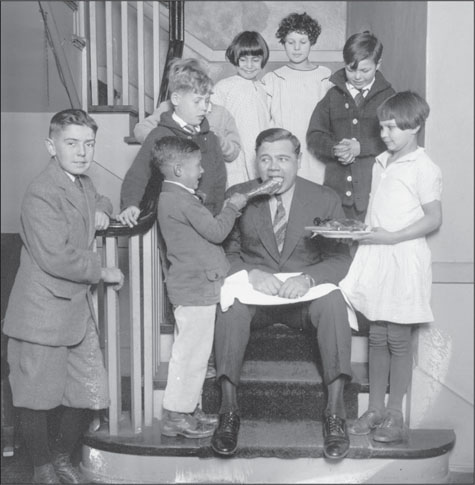
NEW WASHINGTON HOTEL. This c. 1927 photograph was taken of Babe Ruth (1895–1948) when he was surrounded by young children and being fed a turkey leg. Ruth was sitting on the stairs at the New Washington Hotel. The New Washington Hotel manager’s son, Harold Warner, is the fair-haired boy standing on the stairs just above Ruth. (Courtesy of MOHAI, No. 1986.5G.2634.)
MOULTRAY’S FOUR WINDS MENU. On the lower end of Lake Union, at 900 Westlake Avenue North, sat the old City of Everett, a ferry that Chris and Bill Moultray had overhauled into a pirate ship restaurant. The pirate theme followed through to the menu pictured here, as it did in the decor of the restaurant and the pirate costumes of the waitresses. (Author’s collection.)

MOULTRAY’S FOUR WINDS MENU (INSIDE). The restaurant offered frogs’ legs demi-bordelais for $3.75, Caesar salad a la moultray for $1.50 (prepared at the table), charcoal-broiled steaks and seafood, and whole, broiled lobster for $4.50. A Cannon Ball drink (advertised as a drink “for a real he-man, a drink that will shiver your timbers”) was offered for 97¢. (Author’s collection.)
NIFTY RESTAURANT. The Nifty Restaurant was located at 1102 Southwest Spokane Street by Harbor Island in Seattle. It was open for breakfast, lunch, and dinner. (Courtesy of the Southwest Seattle Historical Society.)

NIFTY RESTAURANT (INSIDE). Author Robin Shannon’s father, Roger Shannon, the superintendent of the Texaco plant on Harbor Island, ate here a few times; but even he said this photograph was before his time. (Courtesy of the Southwest Seattle Historical Society.)
NIFTY’S KAYOIA BAR. Ray Smyser is the man in the hat with an unidentified bartender at the Kayoia Bar in the Nifty Restaurant. After Roger Shannon retired from Texaco, his son, Rand Shannon, took over as superintendent, and he remembers the Nifty Restaurant and the Kayoia Bar. (Courtesy of the Southwest Seattle Historical Society.)

NIFTY MENU (INSIDE). The Nifty Restaurant served food 24 hours a day. It served full-course dinners as well as hamburgers and sandwiches. (Courtesy of the Southwest Seattle Historical Society.)
LOWELL DINING ROOM. Herb and Cathie Prior’s Lowell Dining Room was located in the Lowell Apartments at Eight Avenue and Spring Street. Herb, who once worked at Boeing, would make his own pot roast (the specialty of the house) and salads. Cathie made the fresh daily pies and waited tables at dinner. (Courtesy of Mary Patterson.)
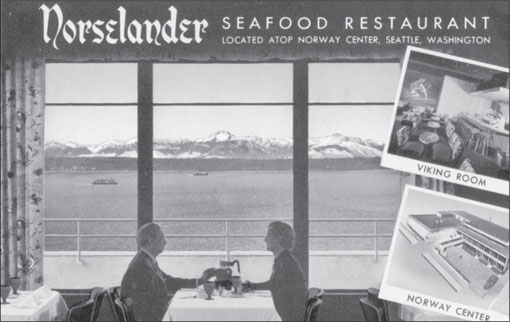
NORSELANDER SEAFOOD EXTRAORDINARY. On the shores of Puget Sound, located at 300 Third Avenue West and Thomas Street atop the Norway Center, was the Norselander Restaurant. This postcard shows a romantic couple, the panoramic view of the Puget Sound, and the snowcapped Olympic Mountains. (Courtesy of John Cooper.)
NORSELANDER MENU. The Norselander Restaurant’s menu featured a Viking longship on the front. A martini or Manhattan cost 60¢. A quote from the back of the menu says, “We hope the warmth and hospitality of the Viking Room and the Norselander will make your visit a memorable one—and that you will soon return to enjoy more of our Seafoods Extraordinary.” (Author’s collection.)

NORSELANDER MENU (INSIDE). The menu pictured here was dated September 1, 1952. On the menu was an Alaska shrimp and crab meat Louie for $1.95. Bread and a beverage were included. (Author’s collection.)
NORTHERN LIGHTS DINING ROOM. This photograph was taken on June 12, 1952, in the Northern Lights dining room, located at 1125 Third Avenue and Seneca Street. The dining room menu included “the Eskimo Legend of the Northern Lights” on the back cover. (Courtesy of the Seattle Municipal Archives, No. 23921.)

NORTHERN LIGHTS KITCHEN. One unidentified chef wearing a tall chef’s hat carves a roast, and another unidentified cook whisks in the kitchen at the Northern Lights Restaurant. (Courtesy of the Seattle Municipal Archives, No. 23918.)
PANCHO’S MENU, 1968. Gary Nunn worked at Pancho’s for eight years for Kaye Pearl, who bought it from Jim Ward (owner of El Gaucho’s). Pancho’s had the last moving sign above the street on Fourth Avenue and Stewart Street. The sign was the Pancho’s logo on a donkey, and the head of the donkey nodded up and down. (Courtesy of Gary Nunn.)

PANCHO’S MENU (INSIDE). Pancho’s restaurant was not a typical Mexican restaurant, but it did have the first open-pit broiler in Seattle. The restaurant’s specialties were broiled steaks and prime rib. It also had its own special French bread called “the Pancho Loaf.” (Courtesy of Gary Nunn.)
PANCHO’S COCKTAIL MENU. Pancho’s had an enjoyable Mexican decor with waitresses dressed in off-the-shoulder blouses like senoritas. There was music playing in the background, and a charcoal broiler kept the room warm. (Author’s collection.)

ROSAND’S SEAFOOD CAFÉ. Rosand’s Seafood Café was located at Ray’s Fishing Resort at 6049 Seaview Avenue. Dorothy and Marvin Rosand built this restaurant entirely over the water, with a spectacular view of the Olympic Mountains. Dorothy’s motto was, “Serve the food beautiful and hot!” (Author’s collection.)
PLAID PIPER MENU. This is a menu from the Plaid Piper, which was located at 1600 Olive Way. On top of the building was a carriage and hobby horse. Bill Cogswell owned and managed the Plaid Piper. The cocktail lounge had subdued lighting and organ music. (Courtesy of Ed and Colleen Weum.)
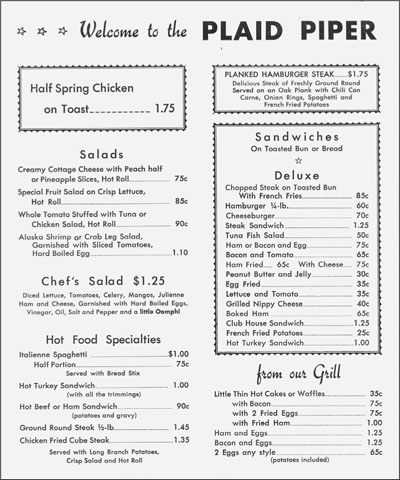
PLAID PIPER MENU (INSIDE). Shown here is the inside of the lunch menu, featuring sandwiches, salads, and breakfast items, along with other choices. On the dinner menu was the restaurant’s specialty, grilled crab legs. Just inside the entrance was a refrigerated case that displayed the homemade pies. (Courtesy of Ed and Colleen Weum.)
PLAZA CAFÉ. Musicians played at the Plaza Sidewalk café in this photograph dated 1959. The Plaza Café was located in the middle of University Street between Fourth and Fifth Avenues, on the site of the World War II Victory Square. (Courtesy of the Seattle Post-Intelligencer Collection, MOHAI, No. 1986.5.11387.2.)
THE PURPLE PUP RESTAURANT INTERIOR. This postcard states, “Seattle’s Most Attractive Restaurant, Times Square, Seattle.” It was located in the Medical-Dental Building. The Depression choked the life out of the Purple Pup, and it closed. In 1932, Walter Clark acquired the space and opened Clark’s Coffee Tavern. (Author’s collection.)

COLEGROVE’S PURPLE PUP MENU. The cover of the Purple Pup menu is seen at right. (Author’s collection.)
COLEGROVE’S PURPLE PUP MENU (INSIDE). The a la carte menu offered a crab or shrimp cocktail for 35¢. A salad was available, but the dressing was an additional cost (Roquefort 25¢). (Author’s collection.)
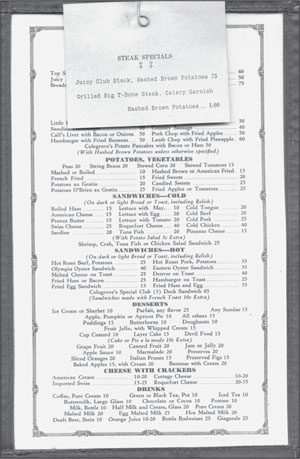
COLEGROVE’S PURPLE PUP MENU (INSIDE). The dinner menu, featured at right, has two steak specials, “Juicy Club Steak and Hashed Brown Potatoes for 75¢ or a Grilled Big T-Bone Steak, Celery Garnish, and Hashed Brown Potatoes for $1.” (Author’s collection.)
ROSELLINI’S FOUR-10 RESTAURANT. The above postcard shows the inside of Rosellini’s Four-10 restaurant. Victor Rosellini became known as Seattle’s premiere host and founded a string of famous and successful restaurants in downtown Seattle. He opened Rosellini’s 610 in 1950, and Rosellini’s Four-10 in 1956. The dining rooms and bars were filled with the most influential and powerful people for nearly four decades. In 1988, Rosellini closed his Rosellini’s Four-10. (Courtesy of John Cooper.)
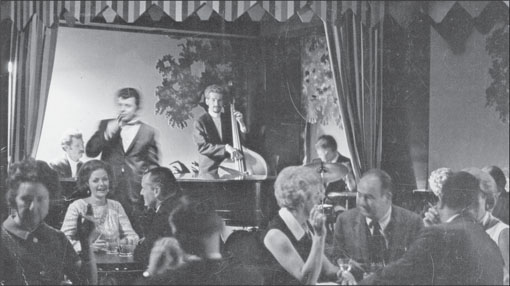
ROSELLINI’S BOULEVARD ROOM LOUNGE. Pictured is the Seattle nightlife in the Boulevard Room Lounge. The lounge offered a collection of rare whiskeys, and wall racks offered a large variety of wines. The room was decorated with world travel posters and gas lamps from Copenhagen. (Courtesy of John Cooper.)
ROSELLINI’S FOUR-10 RESTAURANT INTERIOR. This is a 1959 photograph of Victor Rosellini (1915–2003) beaming over his guests as he offers a menu to Jack Dierdorff and Mrs. Joseph Miccio. A unique wine rack forms a wall in the restaurant, which is located in the White-Henry-Stuart Building at 410 University Street, across from the Olympic Hotel. Magnificent candelabras highlight the sophisticated charm and continental decor of the Terrace Room. (Courtesy of the Seattle Post-Intelligencer Collection, MOHAI, No. 1986.5.11398.1.)
ROSELLINI’S FOUR-10 MENU. The oversized Rossellini’s Four-10 menu featured a continental cuisine. Victor Rosellini’s brother, John Pogetti, was the chef. This restaurant opened without a lunch counter but instead offered a “directors table.” A director’s table is a large table where single customers are seated with other customers instead of at a lunch counter. (Author’s collection.)

ROSELLINI’S FOUR-10 MENU (INSIDE). This oversized menu featured items such as New York cut sirloin for two for $11, planked New York cut for two for $13, Chateaubriand for two for $11.50, and Chateaubriand Bouquetiere for two for $13.50. (Author’s collection.)
ROUGH RIDER ROOM LOUNGE. Written on the back of this postcard was “the Rough Rider Room is one of the Northwest’s most distinctive lounges. A new touch of the Old West gives the Utmost in Comfort and Relaxation.” Located in the Hotel Roosevelt at Seventh Avenue and Pine Street, this lounge had pony-hide patterns on the seats, and the waitresses and bartenders wore Western costumes. (Author’s collection.)
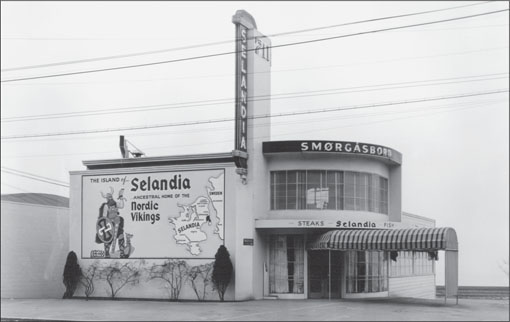
SELANDIA RESTAURANT, 1948. Thematic restaurants reflected the Scandinavian roots of some Seattle natives, as in the Selandia Restaurant and its cousin, the Norselander Restaurant. The Selandia, a smorgasbord, was located at 711 Elliott Avenue West. The signs in the photograph read, “The Island of Selandia—Ancestral Home of the Nordic Vikings. Smorgasbord, Steaks, Fish.” (Courtesy of PEMCO Webster and Stevens Collection, MOHAI, No. 1983.10.16743.)
STEVE’S GAY NINETIES. In South Tacoma, Steve’s Gay Nineties Restaurant and Smorgasbord opened in 1941 with its historic theme and cancan dancers. They used a San Francisco cable car to transport convention groups and parties to this tourist spot. In 1977, Steve’s Gay Nineties Restaurant closed. (Courtesy of Gary K. Nunn.)
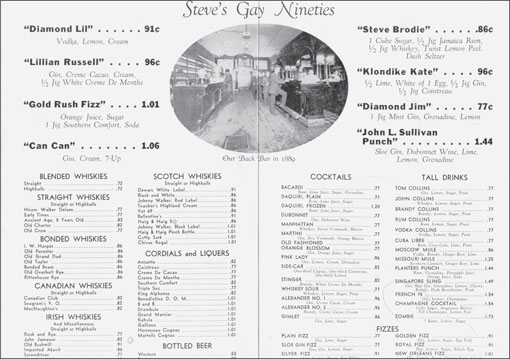
STEVE’S GAY NINETIES MENU (INSIDE). This menu from Steve’s Gay Nineties features an inset of the picture of the back bar. The bar was originally purchased in 1898 for $3,000 for the Red Front Saloon. During Prohibition, the bar was confiscated several times, but in each raid, its beauty and structure kept it from being demolished. In 1928, it was purchased for $50 and moved to Steve’s Gay Nineties Restaurant. If that back bar could only talk! (Author’s collection.)
TEA ROOM, YWCA. This early postcard shows the Seattle YWCA Tea Room. To help “the working girl,” a group of 28 women in 1894 founded the Seattle YWCA. This YWCA offered 10¢ lunches to working women. A depot matron was hired to meet the trains and steamers to “guard and guide young women traveling alone,” as stated in the Winter Prospectus 1901–1902. (Courtesy of John Cooper.)

SKIPPER’S SEAFOODS RESTAURANT. The postcard is of the informal Skipper’s Seafoods restaurant. The restaurant had a lighthouse and included nautical decor inside such as nets, portholes, ship lights, nautical charts on table tops, and driftwood boards of the Sea Shanty. (Author’s collection.)
SKIPPER’S MENU. Featured here is a well-loved Skipper’s Seafood menu. There were two proprietors—Curt Kremer, a musician, and Ernest Hilsenberg, a magician. Skipper’s Seafood received two to three deliveries daily of ocean-fresh seafoods. (Author’s collection.)
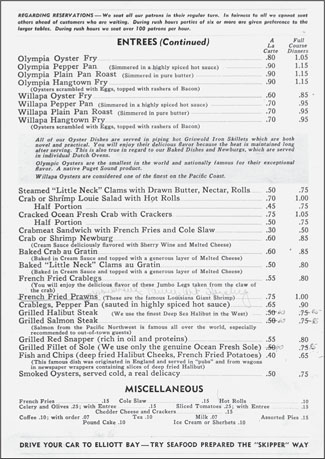
SKIPPER’S MENU (INSIDE). The Skipper’s Seafood menu specialized in seafood, such as Olympia oysters, Willapa oysters, “Little Neck” clams, crab, prawns, halibut, salmon, filet of sole, and snapper. The restaurant was the largest buyer of crab in the United States and served such delicacies as French-fried crab legs and a “Crab Leg Pepper Pot.” (Author’s collection.)
GARSKI’S SCARLET TREE MENU. Built in the Roosevelt neighborhood in 1925, the original restaurant, known as the Wayfair Café, was owned by Lynette Perry. In 1964, Fred Garski bought the restaurant and renamed it Garski’s Scarlet Tree, which is the menu pictured here. (Courtesy of Ed and Colleen Weum.)

GARSKI’S SCARLET TREE MENU (INSIDE). Garski’s Scarlet Tree was located in a one-story, brick-clad building at Sixty-sixth Avenue and Roosevelt Way. They opened for dinner at 5:00 p.m. and once served broiled lobster tail, French-fried potatoes, and a French roll for $2.75. (Courtesy of Ed and Colleen Weum.)
TOP O’ THE TOWN. This postcard is of the Top O’ the Town restaurant. Stated on the back of the menu was, “From this very same hill location, early pioneers watched for the flickering lights of distant sailing ships coming from the Eastern colonies, via the treacherous Cape Horn . . . 120 days from the Barbados . . . 140 days from New York . . . and loaded to the gunnels with quilled-penned mail, bolts of calico, kegs of Irish whiskey . . . and the Mercer girls!” (Courtesy of Mary Patterson.)

TOP O’ THE TOWN MENU. Just outside Seattle’s downtown, at the corner of Madison Street and Terry Avenue, the Sorrento Hotel opened on First Hill in 1908. Several hotels had been built just outside Seattle’s downtown area. Sorrento advertised itself as “a hotel in the heart of things.” The Sorrento Hotel housed a rooftop restaurant, a roof garden, and scenic views of the mountains, the bay, and the Emerald City. (Author’s collection.)
TOP O’ THE TOWN MENU (INSIDE). This menu from Top O’ the Town featured prime rib of Eastern steer beef carved at the table by the chef. Included was a baked potato with all the trimmings, fresh vegetables, garlic French bread, a choice of dessert, and a beverage, all for $4.75. (Author’s collection.)

TOP HAT CAFÉ. Owner Carl Torell is standing in the doorway of his Top Hat Café. He and his wife, Elsie, operated the café from 1958 to about 1960. The café was located at 408 Mercer Street in Seattle. (Courtesy of Jerry Torell.)
HOLLY TREE GRILL. In the beginning, the grill was called Heidi’s Holly Tree Grill until Carl and Elsie Torell took ownership in 1961. They changed the name to Elsie’s Holly Tree Grill. It was later shortened to the Holly Tree Grill. (Courtesy of Jerry Torell.)

HOLLY TREE GRILL (INSIDE). Shown in this photograph is Elsie Torell at her Holly Tree Grill, located at 2 West Howe Street in Seattle. Jerry Torell said that Carl and Elsie Torell had an excellent business as well as a great love for one another. (Courtesy of Jerry Torell.)
VANN BROTHERS RESTAURANT. Pictured is the Vann Brothers Restaurant, located at 4542 California Avenue, on March 1, 1952. Leonard Vann said, “We served real veal cutlets, the type of food that people would come clear from Issaquah or the north end on a regular basis to have. We were a neighborhood restaurant and depended on repeat trade to make it. My dad and uncle started the business under the premise that if we would serve good food, keep the place clean, and give good service at moderate prices, people are going to come back. And that’s basically what happened.” (Courtesy of the Seattle Municipal Archives, No. 23351.)

VANN BROTHERS MENU. Pictured here is a menu from the Vann Brothers Restaurant. “Back in 1922, Vann Brothers was originally located in the Admiral District on the present grounds of the Safeway Store at Admiral Way, across the street from Lafayette Grade School. The reason it was located there was because it was in close proximity to the high school,” said Leonard Vann, the son of one of the Vann brothers. (Author’s collection.)
VANN BROTHERS MENU (INSIDE). Leonard Vann also remembered that, “To begin with it was not a restaurant; it was just a place for the young folks at West Seattle High School to gather and had kind of a gym effect. It also had a soda fountain, candy bars, and so forth, for the kids to gather. And it wasn’t until approximately a year later that my grandmother started to cook roasts and hams and so forth. My cousin and my dad’s younger brother were going to school across the street at Lafayette. He’d go home for lunch. Then with his little wagon, he’d bring the meat, the roasts, the hams and what not, up to the restaurant. They would slice them and serve sandwiches and that was the beginning of starting to serve food. Four generations of Vann’s, including my grandmother, worked there.” (Author’s collection.)

VANN BROTHERS COCKTAIL MENU. “I attribute our success through the generations to the fact that family members are in management and there practically around the clock. They were on top of things and would see that things were kept up and done. They were meticulous in keeping the standards that my dad and uncle had established. Also, our help was just super. We had a waitress who retired after 32 years with us, and a bartender who retired after 25 years with us. You don’t keep people that long unless you treat them right,” Leonard Vann said when talking with the Southwest Seattle Historical Society’s Jon Lee Joseph in 1999. (Author’s collection.)
VANN BROTHERS COCKTAIL MENU (INSIDE). Stamped on the Vann Brothers cocktail menu was, “All prices are our OPS ceiling prices or lower. A list showing our ceiling price for each item is available for your inspection.” (Author’s collection.)
VON’S RESTAURANT. Von’s Rabbit approaches a family dining at Von’s Restaurant on Easter, March 29, 1959. Notice the Kalakala ferry painting behind the diners. Von’s Restaurant had a menu with more than 300 items served 24 hours a day. Located at 1423 Fourth Avenue, Von’s historic restaurant survived Prohibition and is still open. (Courtesy of the Robert H. Miller Collection, MOHAI, No. 2002.46.26.)
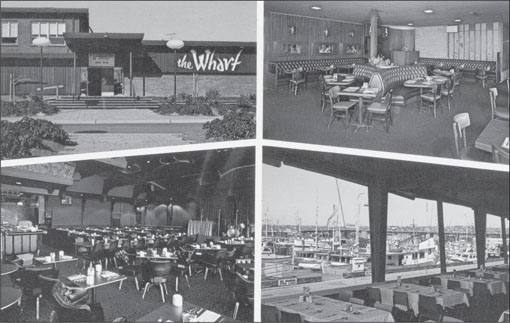
THE WHARF RESTAURANT. This postcard shows the Wharf Restaurant that was located at Fisherman’s Terminal at the south end of Ballard. There was a restaurant, banquet room, coffee shop, and two cocktail lounges. (Author’s collection.)

THE WHARF RESTAURANT (INSIDE). This postcard shows the Wharf Restaurant’s dining room, which was located at 1735 West Thurman Street. Notice the menus on the tables. Plate-glass windows allowed diners a full-length view of the fishing fleets outside, a benefit of being on the wharf. (Author’s collection.)
THE WHARF MENU. Pictured here is the oversized dining menu from the Wharf Restaurant. Approximately two-thirds of the building was the main dining room, with the adjoining lounge called the Mermaid Room. There was an inviting fireplace and saltwater fish tanks with sea horses and starfish. (Author’s collection.)

THE WHARF MENU (INSIDE). Fresh fish was always a favorite at the Wharf Restaurant. It also had daily specials. Monday’s special was corned beef, Tuesday braised tips, Wednesday lamb shanks, Thursday short ribs, and Friday pot roast. (Author’s collection.)
THE WHARF MERMAID MENU. A favorite hangout was the Mermaid Room, with its subdued lighting, deep-cushioned chairs, and organ music. Another bar in the Wharf Restaurant was the Moby Dick, where the drinks were cheaper and the local guys from the fishing boats hung out. (Author’s collection.)
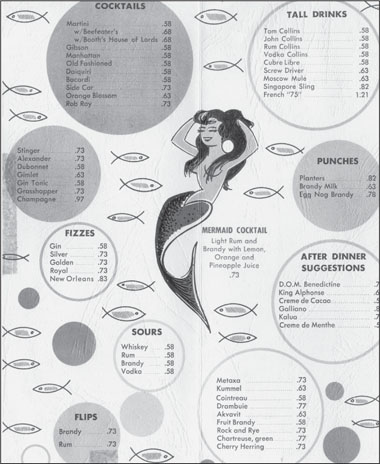
THE WHARF MERMAID MENU (INSIDE). The Mermaid cocktail included light rum and brandy with lemon, orange, and pineapple juices and cost 73¢. The decor included Pacific Northwest paintings and a saltwater fish tank. Art students painted along the wharf, and many locals and tourists visited the Wharf Restaurant and cocktail lounges. (Author’s collection.)